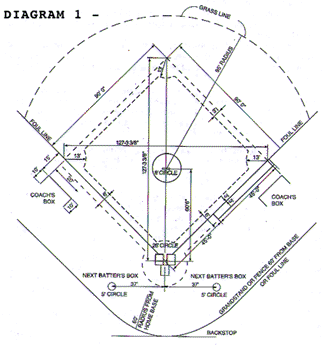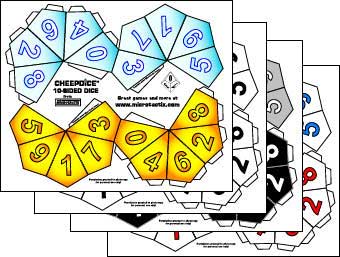 Little Professor Baseball
Little Professor Baseball
We do the arithmetic, so you can play baseball.
Percentile Dice
Rolling 000-999
You may have noticed that results in Little Professor Baseball are
ordered 000 to 999, with higher rolls being better for the player
rolling. The simplest way to generate a random number between 000 and 999
is to roll three ten sided dice. These dice must be given an order
and when they're rolled, that's the order of digits in the result
between 000 and 999.
Example: Earl Weaver orders his dice black,
red, white, and rolls a 2 on white, 6 on black and 3 on red, then the
result is black-red-white or 6-3-2, or 632 for short.
Make Your Own Dice
 If your budget's tight, the professor suggests downloading Microtactix's
Cheepdice and making your own d10s for the cost of some cardboard.
(Please don't ask the Professor why they're called "cheep," when they
are, in fact, free; his head still hurts from placing the apostrophe
in "Microtactix's" and the comma inside '"cheep,".')
If your budget's tight, the professor suggests downloading Microtactix's
Cheepdice and making your own d10s for the cost of some cardboard.
(Please don't ask the Professor why they're called "cheep," when they
are, in fact, free; his head still hurts from placing the apostrophe
in "Microtactix's" and the comma inside '"cheep,".')
Playing Cards as Percentile Dice
The professor has a novel suggestion for generating random
percentiles: use everyday playing cards. First,
divide the playing cards four decks, one for each suit, removing
the face cards. Then, choose your favorite three suits and put them in order.
To generate a random number, you need merely draw a card randomly from
each deck and read it off as a percentile score. Warning: this method
will involve a lot of shuffling. The professor wants you to know that
you should be drawing from the decks with replacement, which
means that after you draw a card from a deck, you replace it and
reshuffle; otherwise, the card sharp will be able to count cards and
have some guess of what the last couple of "rolls" will look like.
Example:
Sparky Anderson is managing the 1970 Reds and somehow finds himself
ten-sided dice, he chooses the following suits in order:
 ,
,
 , and
, and
 .
.
Then when he wants to see how Johnny Bench fares against Jim
Palmer, he makes the following draw:



That's a 2-8-7 given the order he put the suits in, for a result
of 287 on the card.
Platonic Solids and Old-School Dice
Platonic Solids: In the professor's youth, the only dice
available were molded in opaque solid colors in the shape of the five
platonic solids, collectively known as polyhedrons.
Plato showed that there were only five three dimensional objects that
could be made using sides consisting of identical equilateral
polygons.
- d4: tetrahedron (four equilateral triangles)
- d6: cube (six cubes)
- d8: octahedron (eight equilateral triangles)
- d12: dodecahedron (twelve pentagons)
- d20: icosahedron (twenty equilateral triangles)
Percentile Dice: In the professor's youth, d20 were engraved
with 0-9 twice, rather than the contemporary fashion of defacing them
with the markings 1-20. The advantage of the 0-9 range is that a pair
of d20 can be read as a percintile value from 00-99. As long
as you could tell the two d20 apart, the first one would give the tens
place and the second one the ones place. This usage was so common
that a pair of d20 were referred to as percentile dice.
One other historical note: almost everyone treated a 0
as 10, by the way, yielding results of 1-100 rather than 0-99. The
professor believes in truth in advertising and contrary to tradition
will read 0 as 0.
Old School 1-20: d6 and d20
So how did they roll 1-20 in the old days? Simple. With a d6 and a
d20. If the d6 was 1, 2, or 3, the result was what the d20 said
(remember, the markings ranged 0-9, with 0 counting as 10), yielding
results from 1-10. If the d6 was 4, 5, or 6, the result was 10 plus
the result on the d20, yielding results from 11-20.
Old School 1-20: crayon and d20
So how else did they do it? Since some of the dice came without so
much as factory colors in the number, it was common to use permanent
markers or crayons to color in the gaps. If you did it in two colors,
you could generate 1-20 with a single d20. The professor prefers the
old school elegance of the first method.
Home
|
Basic Game
|
Advanced Strategy
|
The Mathematics
 If your budget's tight, the professor suggests downloading Microtactix's
Cheepdice and making your own d10s for the cost of some cardboard.
(Please don't ask the Professor why they're called "cheep," when they
are, in fact, free; his head still hurts from placing the apostrophe
in "Microtactix's" and the comma inside '"cheep,".')
If your budget's tight, the professor suggests downloading Microtactix's
Cheepdice and making your own d10s for the cost of some cardboard.
(Please don't ask the Professor why they're called "cheep," when they
are, in fact, free; his head still hurts from placing the apostrophe
in "Microtactix's" and the comma inside '"cheep,".')
 Little Professor Baseball
Little Professor Baseball
 ,
,
 , and
, and
 .
.


